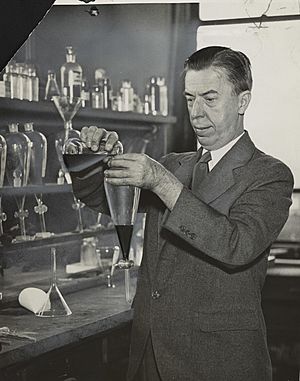Alexander Gettler facts for kids
Quick facts for kids
Alexander O. Gettler
|
|
|---|---|

Alexander Gettler in the toxicology laboratory located on the third floor of the City Morgue, Bellevue Hospital c.1920
|
|
| Born | August 13, 1883 Austria-Hungary
|
| Died | August 4, 1968 (aged 84) |
| Nationality | Austrian |
| Occupation | Toxicologist |
| Known for | Pioneering in the field of toxicology |
Alexander Oscar Gettler (born August 13, 1883 – died August 4, 1968) was a very important scientist. He was a toxicologist and the first forensic chemist to work for a U.S. city. He worked for the Office of Chief Medical Examiner of the City of New York (OCME) from 1918 to 1959.
Gettler worked with Charles Norris, who was the chief medical examiner. Together, they helped create the way modern crime investigations are done in the U.S. Many people called Gettler "the father of forensic toxicology in America." This means he was a pioneer in using science to solve mysteries involving poisons.
There is even an award named after him, called the Alexander O. Gettler Award. It is given by the American Academy of Forensic Sciences.
Early Life and Learning
Alexander Gettler was born in 1883 in a place called Galicia, which was part of Austria-Hungary (now Poland). When he was seven years old, he moved to the U.S. with his father and sister. They settled in Brooklyn, New York.
He went to the City College of New York. Later, he earned his PhD in Biochemistry from Columbia University in 1912. Before working for the city, he was a chemist at Bellevue Hospital. He also taught Biochemistry at the New York University School of Medicine. In 1912, he married Alice Gorman.
Solving Mysteries with Science
In 1918, Charles Norris started the Office of the Chief Medical Examiner (OCME). He asked Gettler if he would do chemical tests for them. Gettler agreed, and they set up a lab on the third floor of the City Morgue building. Here, Gettler looked for common poisons.
Gettler often had to invent new ways to find poisons. He would experiment by adding tiny amounts of poison to animal organs. Then, he would try to find the poison again. His tests often involved mashing up tissues. He would then look at things like how crystals formed, what temperature things melted or boiled at, and how they reacted to different colors.
In 1935, Gettler was the first scientist to use a special machine called a spectrometer in a crime investigation. This machine helped him prove that a poison called thallium did not come from cocoa powder. This was important because an earlier test had made a mistake. It had confused copper from the box with thallium. Gettler's work helped solve a difficult case.
Gettler also wrote many scientific papers about finding poisons like benzene in human bodies. In 1933, he was one of the first to realize that our bodies naturally produce a small amount of carbon monoxide. He also suggested that tiny living things in our gut might help make it.
Even though his work was very important, Gettler often worked for low pay. This was because the toxicology office had a small budget.
Sharing His Knowledge
In the 1920s, Gettler became a professor of chemistry at Washington Square College at New York University. He also taught at the New York University Graduate School. In 1935, he started a special course there just about toxicology. He stopped teaching in 1948 when he reached the age to retire.
Later Years
Alexander Gettler retired from the medical examiner's office on January 1, 1959, when he was 75 years old. He remained interested in toxicology for about ten more years. He passed away in 1968.

